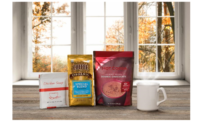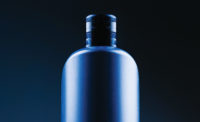Industry Insights: Metallized Film
Making the Switch from Foil to Metallized OPP and PET Films

CPG companies and converters are considering alternative substrates and creative solutions for packaging that incorporates aluminum foil, owing to the uncertainty about the availability and price of foil that has arisen since the U.S. Department of Commerce launched its anti-dumping duty (AD) and countervailing duty (CVD) investigations. Decisions about those investigations are expected in mid- to late-December. Having another qualified substrate ready for use is wise.
Metallized films (OPP, PET, nylon, and cast OPP) are manufactured by means of high-speed vapor deposition that offers converters and end users proven foil replacement solutions for their laminations. In this overview article, we’ll explain the performance advantages of thin-gauge metallized OPP and PET packaging films and review the challenges and considerations involved in exploring a foil replacement.
Foil is known for its outstanding barrier properties and food manufacturers have relied on it for wet and dry food packaging applications for decades. It’s still in widespread use. Among the typical foil packaging applications are powdered and dried food, snacks, confections and dairy items.
However, when metallized OPP arrived on the scene in 1979, end users and converters took notice, and by the early 1980s, improvements in barrier performance had made it a serious alternative to foil. MET OPP film offered and continues to offer flex-crack and puncture-resistance, gas-barrier durability, yield, economic and aesthetic benefits equal to or better than those of foil, and it runs well on pouch lines. Commercial successes of metallized film for foil-replacement include packaging for cocoa powder, spices, seasoning blends, dried soup, sauce mixes, dried cheese, powdered nutrition/energy drinks, oatmeal and snacks. In those cases, end users typically specify a MET OPP for use as a drop-in replacement in paper-polyethylene-foil-polyethylene (PPFP) packets and standup pouches (SUP). Metallized film technology, including MET PET used for packaging, continues to evolve and find new outlets for applications. Among the advances made are thin and ultra-thin films, which offer source reduction, improved barrier, sealant coatings that offer improved hermetics and seal-strength functionality, and other specialty coatings.
Challenges and Considerations
When talking with a food manufacturer about a transition from foil to film, the first step is usually no different from what it is for choosing any packaging film: understanding the functional performances needed for the application. In the case of foil replacement, what was the reason the customer chose foil in the first place? What gas-barrier level is required? How is the packaging going to be handled? Foil is not known for its flex-crack resistance, and a few tumbles during distribution may cause the foil to crease and compromise gas barrier. Film, on the other hand, has excellent flex-crack resistance. Will the food product have sharp edges or points (think of dried pasta or dehydrated vegetable slices in a powdered soup mix)? If so, puncture resistance will be important. Is moisture barrier of greater concern than oxygen barrier, or are they of equal importance? What about light, aroma and flavor barrier? Is FDA compliance necessary? Opening properties are also essential; film solutions require a notch. Stiffness and dead-fold characteristics should also be considered. Money always matters, so how do economics and yield requirements factor in? What equipment is to be used, and what are the targeted line speeds and processing temperatures and conditions? Also, what other application processing characteristics are needed, like co-efficient of friction, which can contribute to more efficient processing and packaging manufacturing?
The conversation with the converter will certainly overlap the conversation with the end user, but it will also explore questions germane to the converting process. How quickly can films be delivered and resupplied? Does the film exhibit good flatness? Foil can be challenging to run, so if the film has good flatness, it should run well on the equipment being used. A flat film will also help with the management of tension control. Good tension control is important in ensuring that line speeds are not slowed. Are different adhesives needed to create the new lamination?
Comparing MET OPP and MET PET Barrier
If we compare MET OPP with MET PET, we find that MET PET typically has superior oxygen barrier and good moisture barrier, but the moisture barrier is usually not as good as that of the MET OPP. However, MET PET’s bond strength and the general robustness of a lamination are superior to those associated with MET OPP, owing to MET PET’s higher tensile properties. The result is less extensibility in laminating and pouching with MET PET. MET PET also has a higher melting temperature, which can give the lamination better thermal stability in the sealing areas.
MET PET is excellent for replacing foil in a lidding application for dairy foods, like yogurt and ice cream, though challenges may present themselves depending on the filling equipment used. It’s also suited for applesauce and puddings. In comparison with foil, it offers better economics, improved barrier durability and superior puncture resistance.
MET OPP delivers excellent moisture barrier, very good oxygen barrier, barrier to light, a highly reflective gloss, better puncture resistance and excellent flex-crack resistance compared with foil, all of which can be achieved at a relatively low cost. It tends to be popular for nutrition bars and higher-end snack food packaging applications.
MET OPP is often designed with a low seal initiation temperature (SIT) heat-seal layer, allowing it to be used in a two-layer lamination. MET PET doesn’t always have this type of heat-seal functionality and is often utilized in a triplex laminate.
Barrier-Durability Performance of Metallized Film and Foil for PPFP Laminations
Gelbo flex testing, the simultaneous twisting and crushing of a packaging film lamination to represent packaging handling, is industry protocol and a standard indicator for the comprehensive robustness of the lamination. It reveals its ability to withstand repetitive strain and resistance to flex-cracking, pinholing and delamination. Toray’s studies have shown that once one begins flexing a lamination made with foil, such as PPFP, the laminate cracks and pinholes, and gas transmission rates increase. A paper lamination made with MET OPP is much more durable and shows significantly less gas-barrier loss (i.e., less increase in gas transmission) over the same number of flexes. Very simply, MET OPP is able to absorb energy during the flexing and twisting because of its chemical composition. The thin metallized layer of the MET OPP is more ductile than foil, and enables it to withstand more flexing without exhibiting deadfold wear.
Toray has also conducted puncture testing, as per ASTM F1306, in which we compared a foil lamination with a MET OPP lamination’s resistance to puncturing forces. That study demonstrated that the MET OPP laminate required a higher force load to puncture than a foil lamination.
Looks Matter
Packaging aesthetics are more important than ever, especially if Gen Y customers (those born 1977—1994), who are image-driven and exceptionally visually-oriented, are targeted, or if multigenerational marketing is part of the end user’s strategy. Packages made with foil tend to crease and may bear a shop-worn look after shipping or in a store when consumers pluck an item off the shelf or display, handle it and then put it back. Our studies show that a MET OPP pouch retains its shape and does not exhibit wrinkles or creases, as seen in a foil pouch.
Sealants: To Integrate or Not to Integrate?
Packages need to be sealed to prevent product loss or contamination and to maintain shelf-life flavors. Foil alone is not sealable, so some type of sealant technology is needed. Typically, that is achieved by laminating foil with a specifically-designed sealant web (for example, a blown polyethylene film) or extrusion coating the foil with a sealant material.
Metallized films are available with or without integrated sealant technology. Having integrated sealant technology means that the MET OPP or MET PET film has a heat-sealable layer or functionality built into it without its requiring an additional processing step, so the need for the addition of a separate sealant web or coating is eliminated.
The additional feature of integrated sealant technology allows for the replacement of the foil and extrusion-coated sealant layers or separate sealant films. Depending on the type of product to be packaged, integrated sealable metallized films can be selected or designed to work very well with that product, and, if necessary, provide seal-through-contamination properties.
Integrated sealant technology also offers source reduction, as it eliminates the need for an LDPE or other sealant layer.
Metallized film is a proven replacement for foil in packaging. Planning ahead and having a readily-available qualified substrate for foil-replacement can offer peace of mind during this time of uncertainty. Those who are considering foil-replacement for the first time should know that many have gone before with great success. Today’s advances in metallized film and sealant technologies make it an even more reliable alternative to foil.
Toray Plastics (America), www.toraytpa.com
Looking for a reprint of this article?
From high-res PDFs to custom plaques, order your copy today!







